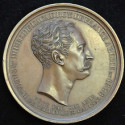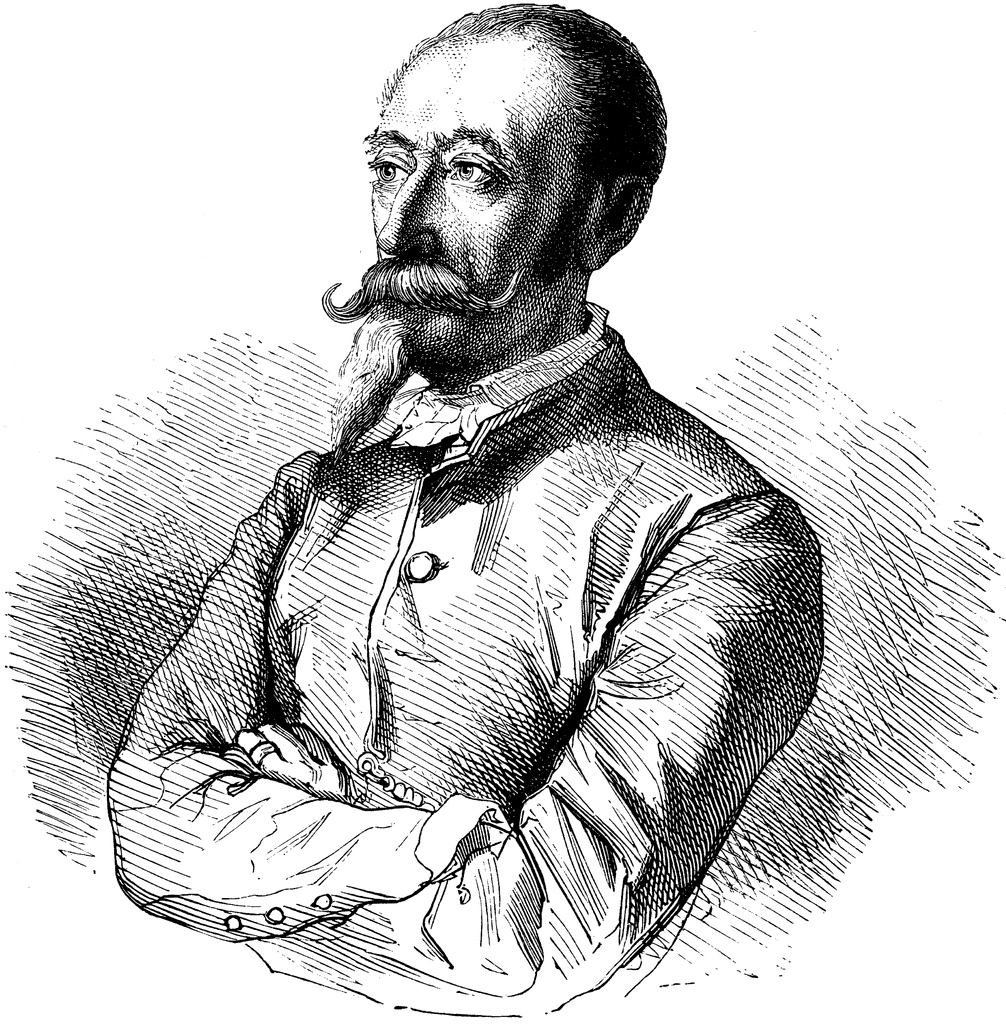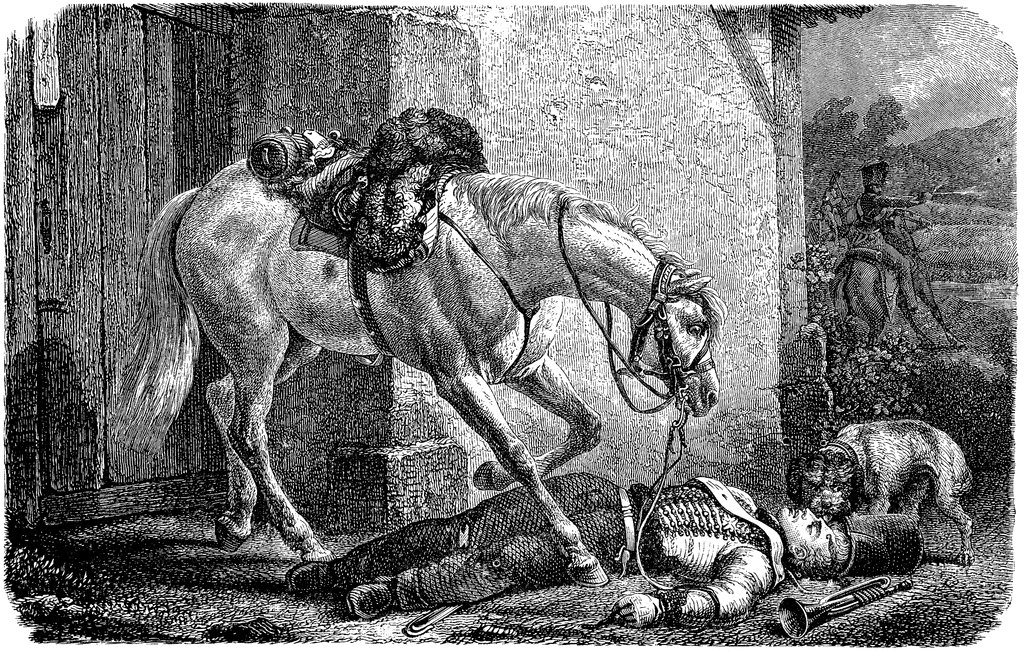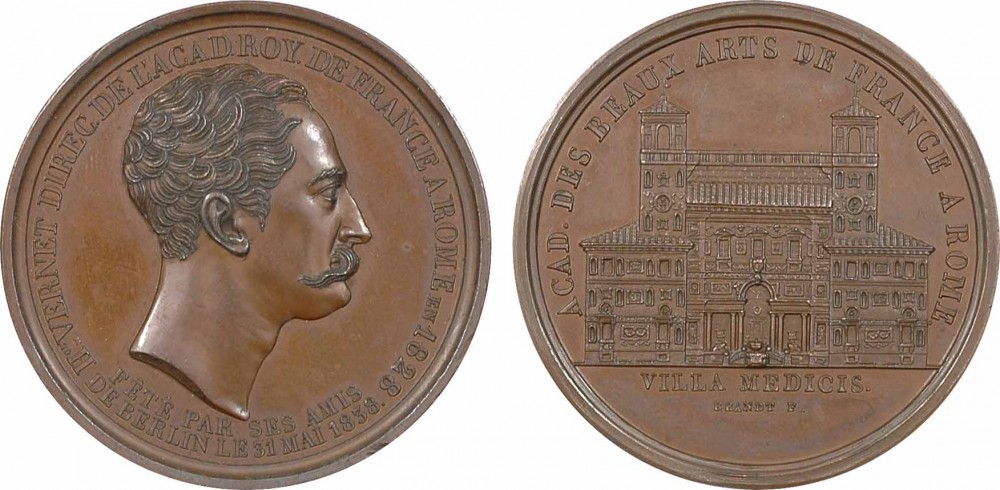A Scion Society of The Baker Street Irregulars

Sherlock Holmes’ Great Uncle? – The Artist Horace Vernet
Readers of Sir Arthur Conan Doyle’s Sherlock Holmes adventure “The Greek Interpreter” (1893) may remember that the story begins with Holmes and Watson “discussing hereditary aptitudes” after tea one summer’s evening. “In your case”, Watson tells Holmes, “it seems obvious that your faculty of observation in your peculiar facility for deduction are due to own systematic training.” “To some extent,” Holmes replies, “but, nonetheless, my turn that way is in my veins, and may come with my grandmother, who was the sister of Vernet, the French artist.”
That Doyle chose to give his hero artistic relations is not surprising, for Doyle’s own uncle was an artist, as was his grandfather. The choice of a French artist was probably to give Holmes a more cosmopolitan background, just as Ian Fleming was later to give James Bond a Swiss mother. Why Doyle chose a real artist, Emile Jean Horace Vernet, is less clear. Perhaps it was because Vernet was popular in Britain. Many of his works had been bought by his friend the francophile 4th Marquess of Hertford (1800 – 1870) and a number had been exhibited at Bethnal Green in the mid-1870s. Even a brief English biography of Vernet had been published in 1880.

Horace Vernet came from a family of painters who stretched back to the late–17 century Avignon. His great – grandfather Antoine Vernet had been a painter, as had his grandfather Joseph (1714–89), a landscape artist who had spent much time in Italy and who had painted a series on French ports for Louis XV. His father Carle (1758 – 1836) had continued the tradition, specializing in horses and, later, in Napoleonic battle scenes. Horace was born on June 30, 1789, in Joseph’s apartment in the Louvre. From an early age he showed the same talent as his predecessors, although he did not work very hard, and while still a child he was introduced to his father’s artistic friends at the Café Foy. We are told that when the ceiling was damaged by ill-aimed champagne corks, Horace climbed a step–ladder and painted a swallow over the damage, thus creating the “Academie de l’Hirondelle,” as the artists and poets who met in the room were later to be called. By 1802 13-year-old Horace was selling his paintings at 20 Francs each.
Carle wanted his son to paint horses but Horace, brought up in a country fighting for its life against external and internal enemies, preferred military subjects. This is probably encouraged by his father’s battle paintings and his military friends. The advent of Napoleon was hardly likely to dampen the boy’s martial spirit, and Horace actually asked his father for permission to join the Imperial Army. Carle refused, but allowed Horace to become a military draughtsman instead. Horace would remain a Bonapartist for the rest of his life.
In 1814, the young Vernet finally got to see action, although hardly in the best of circumstances. As a second lieutenant in the Garde Nationale he fought alongside his father at the Barriere de Clichy as Prussian and Russian troops entered Paris and Napoleon’s Empire collapsed around his ears. For this he was made a Chevalier of the Legion of Honour. He would later produce a painting depicting this doomed rearguard action of the last days of the war.
After Waterloo, Horace Vernet did little to ingratiate himself with the new Bourbon authorities. He painted Bonapartist subjects, some of which were exhibited in the 1817 and 1819 Salons, and gravitated clearly towards the opposing Orleanist branch of the French royal family, which had initially supported the Revolution. Despite having an aunt guillotined during the Terror for supporting her husband’s Royalist views, Vernet was forced to accompany his father to Italy in 1820 to get away from Bourbon displeasure. In 1822, seven of his pictures were rejected by the Salon for political reasons (reportedly because some of them depicted tricolour insignia). Vernet prints, however, sold like hot cakes, and it would appear that the government did not wish to alienate such a successful artist irreversibly. A pro–Bourbon paper therefore suggested that Monsieur Vernet might wish to exhibit his works privately, and Horace at once set up his own rival salon in an upper story of his house in the rue de la Tour-des-Dames. There were 40 pictures on show, including an allegory on Napoleon’s death (in 1821) which was draped in black. The show was a great success and Vernet found himself working in a studio full of ex-soldiers, artists and fashionable ladies, all discussing the recent history of France as it was portrayed in his paintings. Vernet seems to have found this atmosphere congenial and, as we shall see, the studio was to continue to have the atmosphere of a busy coaching inn even after he had become a respected member of the establishment.
Stylistically, Vernet was neither a Classicist nor a Romantic. He painted his own subjects in his own way although probably not without having an eye to their commercial success. His one true attempt to move towards Romanticism, “Edith seeking the body of Harold after the battle of Hastings,” was a critical disaster and he never leaned so far towards Romanticism again. Vernet worked hard, once going without sleep for days while thinking alley picture, and he was kind and helpful to students and customers alike. Poor students could expect tuition from him for no charge and an ex-cuirassier one thing a portrait for his mother was charge only 1 1/2 francs because that was all he had.
The 1822 exhibition marked the beginning of a thaw in relations between Vernet and the Bourbons. Anxious to snatch the artist from the Orleanist opposition, King Charles X asked for a portrait sitting with Vernet and then applauded the result, commissioning another.
By 1825, Horace had been made an Officier of the Legion of Honour and in 1826, he was elected to the Institut des Beaux-Arts, sitting next to his father. His paintings became more politically correct picking Louis XVI’s last hunting party or neutral subjects like “Edith” and the French victory of Bouvines (1214), although the number of his pictures exhibited at the Salon was still small. In 1828, he was made Director of the French Academy at Rome, despite having failed the Prix de Rome in 1810. Some believe that his posting was intended to drive him yet further from Napoleonic subjects, as well as to serve as an apology for earlier Bourbon neglect. Vernet certainly took to painting Italian scenes and these, for example “A Roman Herdsman…” (Wallace Collection), are among his worst works. However, he maintained his links with the Duke of Orleans and his admiration for Napoleon.
It is at about this time that the first two medals commemorating Vernet with which I am familiar appeared. There are probably several other Vernet medals which I have been unable to discover. This medal was the work of P. J, David (1788-1856) known as David d’Angers, a Neo-classical sculptor who nonetheless produced some 500 cast bronze medallions that were essentially Romantic in style. These medals, a private venture, depicted famous contemporaries from both Europe and America and were uniface round pieces bearing relief portrait busts. Some say that they are the best Romantic portrait sculpture. Twenty years ago they were almost completely uncollected, but today the best examples can cost up to £600. Later cast exists, but even these are far from cheap, which is a pity, for the David d’Angers medallions make most early 19th century medals look about as aesthetic as telephone jettons.

Vernet proved to be an excellent Director of the Academy, giving brilliant parties and continuing the tradition of Bohemian conviviality in his studio, now a small house on the grounds of the Villa Medici, the French school at Rome. The composer Mendelssohn described the studio as follows: “as you approach you hear a tumult, shouting and wrangling, or a piece executed on a trumpet, or the barking of a dog… The most picturesque order prevails everywhere – – guns, a hunting horn, a monkey, palettes, a couple of dead hares or rabbits, the walls covered in pictures…”.
In July 1830, Charles X was overthrown and replaced by the Duke of Orleans, henceforth King Louis-Philippe I. Orleans had been buying Vernet’s work since 1817 and one of his first acts was to point Vernet as temporary diplomatic representative in Rome to replace the pro-Bourbon Ambassador. Vernet’s duties must have required him to wear a tricolour sash, which he no doubt found highly satisfying. The Romans, though, were generally pro-Bourbon, and Horace was threatened to such an extent that his wife and daughter could not leave the Villa grounds. Vernet stuck to his post regardless. In France, meanwhile, the new regime meant that his Napoleonic and revolutionary subjects could at last be exhibited officially, which they were at the 1831 Salon, and he was asked to produce a series on French military themes for Versailles, soon to become a public museum.

Despite the dangers of his brief diplomatic service, Vernet remained dissatisfied with life as an artist and still hanker after military experience that he had been deprived of in his youth.
Despite a pleasant lifestyle he did not like Rome, and sometimes he would run to the window on hearing a drum, eager for the opportunity to see a formation of troops. In 1833, therefore, he accompanied the French army to Algeria. In addition to the military subjects this generated, the expedition gave Vernet an abiding interest in Orientalist themes. Like many at the time he felt that the world of the Bible could still be seen in Arab countries, and he now painted a series of oriental and Biblical works which were criticized by some, much to the chagrin of his wife. Vernet ignored this criticism, saying “what importance have the remarks for me, if they are wrong?” The public supported him, and the new political climate allowed him to produce more Napoleonic subjects as well.
In 1835, Vernet left the Villa Medici, having first seen his daughter married to his friend Paul Delaroche (b. 1797), an artist stylistically similar to himself. Vernet became Professor at the Ecole des Beaux-Arts at Paris and visited North Africa, Egypt, Palestine, Syria and Russia in search of subject matter. In 1838, a group of German artists, whom Vernet had probably met in route for Russia in 1836, marked the 10th anniversary of his appointment to the Villa Medici by commissioning a medal.
The medal is a large (47mm) piece in struck bronze by the Swiss medallist Henri Francois Brandt (1789 – 1845). Brandt had been apprenticed to a watchmaker in 1800 before moving to Paris in 1807. There his countryman J. P. Droz, the Keeper of the Paris Medal Mint, had procured him a post as an engraver. While in Paris, Brandt had studied under the artist Louis David (no relation to David d’Angers, and bitterly hated by Vernet because of his failure to prevent the execution of Vernet’s aunt). In 1814, he had gone to Italy, and in 1817 he moved to Berlin where he became First Engraver of the Royal Mint, a post that he kept until his death. Brandt was described by one contemporary critic as “the greatest medalist of Berlin,” although his style was somewhat cold and formal. The 1838 medal bears Vernet’s distinctive bust and profile on the verse and a beautifully detailed view of the Villa Medici on the reverse. The first inscription reads “Hce VERNET DIREC. DE L’ACAD. ROY. DE FRANCE A ROME en 1828 / FETE PAR SES AMIS DE BERLIN LE 31 MAI 1838.”

In 1842, Vernet was made Commandeur of the Legion of Honour. Unfortunately, a series of personal disasters was about to dog the artist just as he reached the peak of his career.
In December 1845 his daughter Louise died after a long illness. Traumatized, Vernet did not work for a long time only emerging from his self-imposed retirement when Louis-Philippe begged him to paint a ceiling in the Louvre. Unfortunately, Vernet had hardly returned to his craft when his patron was overthrown in the 1840 revolution, during which several of Vernet’s battle pictures were destroyed in a fire. These shocks, to which can be added Vernet’s near death in no less than two shipwrecks, led the artist to withdraw into himself. He sold his home and much of his art collection and retired to a small apartment inside the Institut de Beaux-Arts.
The rise of Napoleon III meant that Vernet was soon enjoying official patronage once more, but the years 1845–48 nonetheless marked a significant watershed in his life. The critics were turning against him in greater numbers and his visit to the front and the ineptitude-ridden early stages of the Crimean War seems to have eroded some of his belief in martial glory. Even his recognition as one of the most important painters of the past few decades, made official by the award of the grand medal of honour at the 1855 “Exposition Universelle,” where 24 of his works were on show, does not wipe out the general feeling of decline. Then, to cap it all, in 1856 his wife died. Although Horace married the daughter of a British general in 1858, his first wife’s death had been a severe blow and his health now collapsed. To a large extent his new wife was to be more his nurse than his partner. In 1862, he was made Grand Officer of the Legion of Honour, but by now he was dying. He wanted to return to the south of France, where his family had first turned to art, but he died at the Institute on January 17, 1863. He is buried in Montmartre Cemetery, his grave marked by a white marble memorial bearing and Orientalist design of stars and crescent moons. As a mark of respect, the Institut des Beaux-Arts did not appoint a successor to his seat for six months.
This is not the place to discuss Vernet’s art in detail. He has been described as “popular and facile” and his success can be attributed more to his choice of subject than to his skill. In part, he admitted this himself, saying that his paintings appealed to “the military instincts of our country… It’s anti-Bourbon prejudice… (and) to bourgeois sentimentality…”

His pictures are tied to a specific time and place and an interest in both is probably needed to appreciate them. His Orientalist works, however, are colorful and distinctive and his battle, as opposed to military genre, pieces give a good impression of the smoke and confusion of a Napoleonic engagement. Four of his battle pictures can be seen in the National Gallery, while the Wallace Collection contains a fine selection of Vernet’s, mainly in Rooms 11 and 23. I would strongly recommend anyone interested in Vernet to go and look at the pictures at first hand.
This article was originally published on pages 30-33 of the March 1993 issue of Coin News and is reprinted here with permission.
Thanks also to David Hill, Librarian of the American Numismatic Society for his assistance in providing us with a copy of this article.

Interesting how both Vernet and Doyle felt the call of the military.